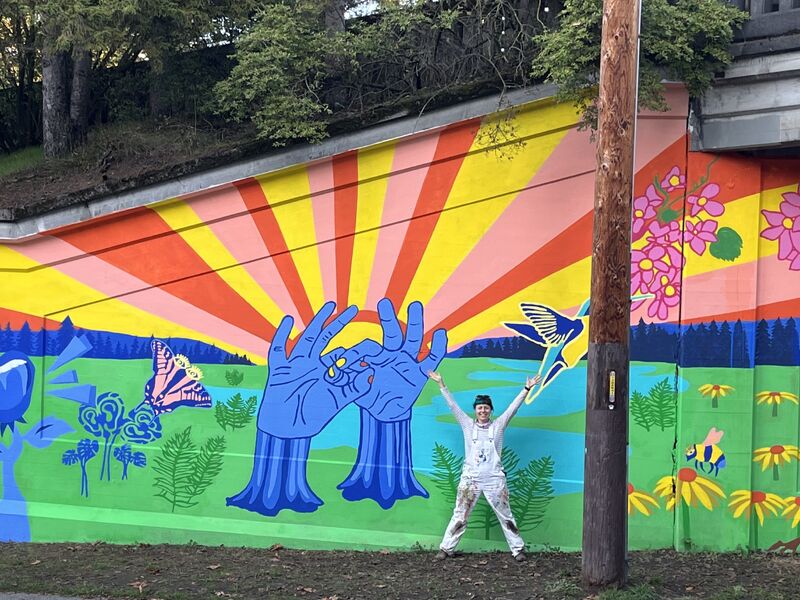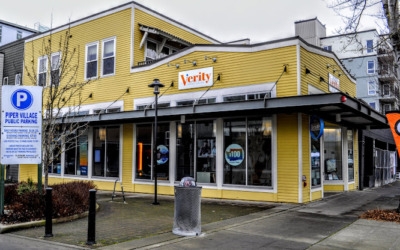By Abby Armato, Special to the Blog
We are thrilled to share our full conversation with Aistė Rye, one of the two muralists who worked on the mural Connect for the 63rd Street Mural project. Connect features vibrant creatures with big eyes, a dark forest with screaming mouths, and at the center, hands painted in the American Sign Language sign for ‘connect.’ As Aistė tells us in our conversation, she and her project partner Mia designed the piece to bridge the gap between the Deaf and hearing communities. As artists who are a part of the Deaf community, the muralists hoped to start a larger conversation about the importance of sign language and call attention to audism and the discrimination Deaf people face in an audio-centric world. At the heart of the piece, the mural asks us as a community to reflect on how we can work together to create a peaceful place and truly connect with each other.
Learn more about this talented artist and her work in the conversation below, and be sure to visit the Connect mural located on 63rd Street under the Aurora Bridge near Green Lake!
What is your name?
My name is Aistė Rye, and I’m a muralist, visual designer, and educator. I teach therapeutic art workshops, and work as a Teaching Artist with Urban Artworks..
Why is public art important to you?
I was born in Lithuania during the post-Soviet Union in 1992, and I don’t recall seeing any kind of public art except for military leaders or brutalist sculptures in my neighborhood in Klaipėda. When I moved to places in the US, there was vibrant art everywhere. It was inspiring, and it felt like there was a sense of belonging. Studies show that public art can reduce crime and encourage more public access and people enjoying the space more. I think it brings a lot more joy and vibrancy to our communities.
When and why did you get involved with the PNA?
I got involved with the PNA when my project partner reached out to me about the call for art at the 63rd Street mural. Since we both are Deaf (I’m Deaf/Hard of Hearing), we wanted to create a mural that spoke to both the Deaf and the hearing communities.
I specifically wanted to apply because Phinney was the first place I visited in Seattle. After exploring the neighborhood and checking out the art scene, restaurants and local businesses, I felt like it was like the place I wanted to be if I could move to Seattle. My visit inspired me to move here during the pandemic in 2020.
Tell us about the concept for the 63rd Street mural.
The 63rd Street mural concept was born from wanting to bridge the gap between the Deaf and the hearing communities: to invite the hearing communities into the Deaf world and also educate people about Deaf culture and American Sign Language.
Since my project partner and I are both artists that identify as Deaf, it was really important to us to represent our community, but also to start a bigger conversation. What is sign language like? Why is it important? What is audism and discrimination against Deaf people or people who can’t hear?

We wanted it to be inspiring and inviting, and that’s why we use the sign ‘connect’ on the mural to pique people’s interest and curiosity. Some people that walked by when we were painting knew some sign language, and they were like, ‘Oh, that means connect,’ which I thought was really cool. The idea is to connect the two communities together and to learn more about each other.
That is in the more vibrant, peaceful part of the mural. There’s also a hummingbird and butterfly with big eyes. We chose eyes because, in the Deaf community, and Deaf people in general, rely on their sight a lot. So we often use eyes and hands in the Deaf art movement.
If you look farther to the left, it’s darker—this forest. There’s a bunch of lips screaming, representing the discrimination and audism that often happens in the Deaf community: assuming Deaf people can hear, or talking to them and not realizing they only rely on sign language, or maybe they don’t know sign language at all. It represents that world.
The mural vacillates from the audism to this more peaceful, vibrant world and asks: how can we get there and connect with each other? How can we start those conversations through learning about each other?
Why is participating in your community important to you?
It really creates a sense of belonging and a sense of home. I think it’s also just a part of who I am. No matter where I live, I really feel like I need to be rooted and know the people in my community, especially as an artist.
As artists, we are culture keepers. It’s important to know what’s important to our community and what our community wants to say. I’m very engaged in the Deaf community, so I feel like a lot of my art is inspired by that community and is reflected in the work that I make. Really listening and caring, I think it just creates a lot more investment in our community.
This interview has been condensed and edited for length and clarity.





